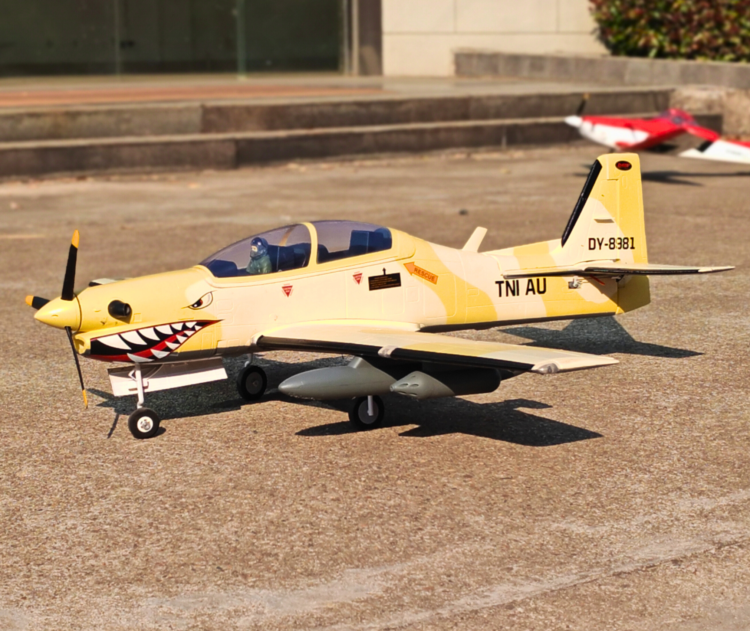As an experienced RC pilot and a long-time enthusiast of Dynam aircraft, I have experimented with various setups to enhance flight performance. One of the most critical components of any RC planes is its power system, particularly the motor. High-torque motors are often recommended for certain applications, but knowing when to use them can make all the difference in flight efficiency, maneuverability, and overall performance. In this article, I will break down when and why a high-torque motor is the best choice and share my personal experience flying the Dynam P-47D Thunderbolt V2 4S RC Warbird Plane 1220mm w/ Flaps with different motor setups.

What Is a High-Torque Motor?
A high-torque motor is an electric motor designed to generate more rotational force (torque) at lower RPMs. This allows the plane to use larger propellers or handle heavier loads more efficiently. Unlike high-speed motors, which prioritize RPMs, high-torque motors focus on raw power output, making them ideal for specific flying conditions.
Benefits of High-Torque Motors
- Increased Thrust: Supports larger propellers for better static thrust.
- Better Efficiency: Delivers power at lower RPMs, reducing energy waste.
- Stronger Acceleration: Ideal for takeoff-heavy applications like warbirds and large trainers.
- Improved Load Handling: Suitable for carrying payloads like FPV gear or extra batteries.
- Enhanced Low-Speed Control: Allows better maneuverability for scale flying and aerobatics.
When to Use a High-Torque Motor in RC Planes
1. Flying Large or Heavy Models
If your RC plane is large or has significant weight, a high-torque motor is crucial. These motors provide the necessary power to keep the aircraft airborne without excessive strain.
Examples:
- Warbirds & Scale Models: Dynam P-47D Thunderbolt V2, B-26 Marauder
- Balsa Wood Planes: Heavier than foam models, requiring extra torque
- Twin-Engine Planes: Need stable thrust to prevent asymmetric yaw
2. Running Large Propellers
High-torque motors excel in setups that require large-diameter propellers. Larger props generate more thrust at lower speeds, which is advantageous for slow, controlled flights and heavy-lifting aircraft.
Examples:
- 13×6 or 14×7 propellers on 4S-6S systems
- Large-scale aircraft needing extra prop bite
3. Flying in Windy Conditions
High-torque motors provide better responsiveness, making them an excellent choice for windy environments. With more consistent power output, they allow pilots to maintain stability and control even in gusty conditions.
My Experience:
Flying the Dynam P-47D Thunderbolt V2 in moderate winds, I noticed significant improvements when switching to a high-torque setup. The added torque helped maintain steady flight paths and precise maneuvers.
4. Short Runway or Grass Takeoffs
Planes requiring short takeoffs benefit greatly from the extra acceleration that high-torque motors provide. The increased low-speed thrust ensures the aircraft gets off the ground quickly and efficiently.
My Experience:
I often fly from grass fields, which can be a challenge for certain warbirds. With a high-torque motor, my P-47D Thunderbolt V2 lifts off smoothly with minimal struggle, even on uneven terrain.
5. Aerobatics & 3D Flying
Maneuvers like hovering, torque rolls, and slow-speed loops demand strong torque at lower RPMs. High-torque motors provide the necessary power to sustain these moves without over-reliance on momentum.
Examples:
- Torque rolls in aerobatic models
- Slow-speed loops and hammerheads in warbirds
My Experience with the Dynam P-47D Thunderbolt V2 and a High-Torque Motor
Initial Setup
When I first got my Dynam P-47D Thunderbolt V2, it came with a stock TomCat 3720-600KV motor. While this motor performed well on a 4S setup, I wanted to test how a high-torque motor would impact its flight characteristics.
Upgrading to a High-Torque Motor
I swapped the stock motor for a TomCat G60 500KV motor paired with a 14×7 propeller. The difference was immediately noticeable:
- Smoother Takeoffs: Less throttle required for lift-off
- Better Energy Efficiency: Longer flight times with steady power output
- Improved Climb Performance: Easier to perform scale maneuvers like chandelles
- Stronger Low-Speed Handling: More control during landing approaches
Flight Test Results
| Aspect | Stock Motor | High-Torque Motor |
|---|---|---|
| Takeoff Performance | Moderate | Strong, smooth acceleration |
| Flight Efficiency | Decent, but power-hungry | More efficient at low RPMs |
| Climb Rate | Satisfactory | Excellent |
| Wind Handling | Good | Superior stability |
| Low-Speed Handling | Average | Significantly improved |
FAQs About High-Torque Motors in RC Planes
1. Does a high-torque motor reduce flight time?
Not necessarily. A high-torque motor often runs at lower RPMs with a more efficient power draw, which can actually increase flight time compared to a high-speed motor operating at maximum throttle.
2. Can I use a high-torque motor on a lightweight RC plane?
While possible, it’s usually unnecessary unless you need better prop efficiency or are flying in high-wind conditions.
3. How do I know if my RC plane needs a high-torque motor?
If your plane struggles with takeoffs, requires more power for large propellers, or needs extra control in windy conditions, a high-torque motor is a great upgrade.
4. What’s the best battery setup for a high-torque motor?
It depends on the motor specs, but generally, a 4S or 6S LiPo battery provides optimal power without excessive current draw.
5. Will a high-torque motor affect stall speed?
Yes, it can lower the stall speed slightly by allowing better control at low speeds, making it ideal for warbirds and scale flyers.
Conclusion
Choosing a high-torque motor for your RC plane can significantly improve performance, especially for warbirds like the Dynam P-47D Thunderbolt V2. From smoother takeoffs to enhanced wind resistance, the benefits are well worth considering if you’re looking to upgrade your setup. My personal experience with the TomCat G60 500KV motor in this warbird has been exceptional, and I highly recommend experimenting with different power configurations to find the perfect balance for your flying style.
Whether you’re a scale warbird pilot or an aerobatic enthusiast, a high-torque motor could be the missing component that takes your flights to the next level.


